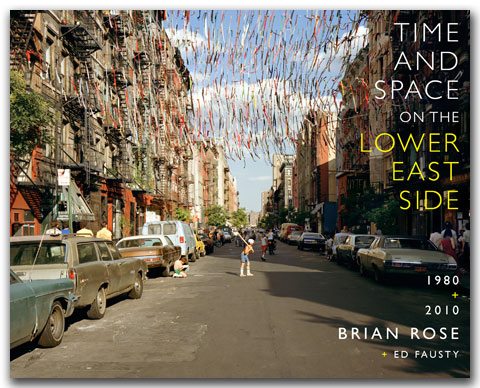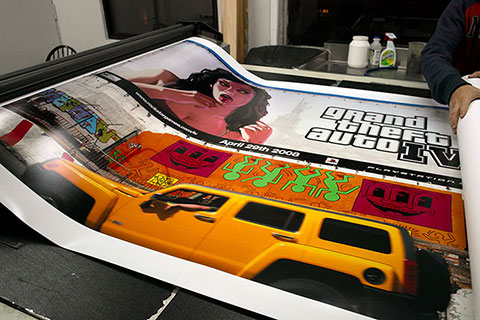

| The limited edition of Time and Space includes a slipcover and 8x10 print inside. The limiteds are signed, dated and numbered in an edition of 100. |



Ed Fausty and Brian Rose, 1980

Brian Rose, Photo by Ed Fausty, 1980

Dillon Gallery, March 2013

Making a 50x60 inch print at the lab

Time and Space on the Lower East Side In 1980, Brian Rose, in collaboration with Edward Fausty, photographed the Lower East Side of Manhattan with a 4x5 view camera. It was the neighborhood’s darkest, but most creative moment. While buildings crumbled and burned, artists and musicians came to explore and express the edgy quality of the place. For more than two decades that work sat unseen in Rose’s archive as he went on to other projects, most notably his long-term documentation of the landscape of the Iron Curtain and the Berlin Wall. After the wrenching events of 9/11, Rose was drawn back to New York as a subject for his camera. He began thinking about making a response to what had happened to the city, one that would take a longer view of the impact on New York and beyond. Eventually he decided to return to where he had begun--the Lower East Side--the place where so many Americans traced their roots. The old neighborhood tucked beneath the bridges, lying at the feet of the pinnacles of power, would serve as a barometer of change and continuity. From the outset it was clear that this would not be a simple before/after take on the place. While keeping an eye on the earlier photographs done in 1980, Rose sought to rediscover the place with fresh eyes, with the perspective of time, change, and history. The result, Time and Space on the Lower East Side, is a set of photographs that looks backward and forward, that posits the idea that places are not simply “then and now,” but exist in a continuum of decay and rebirth. |
Press
• The
New York Times, May 8, 1981
...Fausty and Rose present an accurate report on the neighborhood that is affectionate without being sentimental. They have eschewed cliche shots of colorful ethnics, old people with picturesquely seamed faces and visual poems about the romance of decay, choosing instead to take the beauty and the dirt as it comes.
• ArtForum,
September 1981
The marvelous thing about their work is that they wield their four-by-five camera, with color sheet film, as facilely as if it were a hand camera.
• Manchester
Photography, December 10, 2007
his work is important, and as good landscape/documentary work as I have seen.
• B
(Rumblings from the Photographic Hinterlands), August 18, 2010
It's pretty rare for a photo book to feature the full package: Great photos and eloquent writing, and of historical/documentary interest. "What is interesting about photographers is the nature of the balance they create: the place where they draw that line between their own presence and the mindless memory of their cameras." On that continuum, Rose is somewhere between Shore and Friedlander. Three of a perfect pair.
• Reciprocity
Failure, July 23, 2010
Sometimes you really need a view camera to get that particular feel of a street landscape that smaller formats just cannot deliver, particularly in a city infamous for its lack of horizon lines.
• EV
Grieve, July 14, 2010 (1)
• EV
Grieve, July 14, 2010 (2)
• bowery
2.0, January 7, 2011
• Reciprocity Failure, March 28, 2012
Time And Space On The Lower East Side forever captures a good part of what will always be my New York- a bit broken, somewhat foreboding, and always promising more (much more) than it can ever possibly deliver.
• Conscientious, May 18, 2012
...what you can take away from Time and Space on the Lower East Side is that its maker really loves the city and, of course, that he is a very good photographer.
• Manchester Photography, June 7, 2012
We're dipped into the past and back again, you lose track of whether you are back then or there now.
• Cool Hunting, June 8, 2012
'Time and Space' breaks from the before-and-after mold by rejecting strict side-by-sides of the changed landscape ... Part of Rose's talent is his ability to look past nostalgia to find character in the neighborhood then and now.
• The Morning News, June 11, 2012
• DART/Design Arts Daily, June 12, 2012
Seen together, and sequenced in a seemingly random way, the images avoid the quaint and the dramatic. Instead they reveal the embodiment of a particular urban experience recalled as a sense of place.
• The Local: East Village, June15, 2012
• The Wall Street Journal, June 15, 2012
But don’t expect his new book to be a traditional then-and-now collection forlorn about the march of time.
• EV Grieve, June 27, 2012
• The Daily Beast, July 11, 2012
• Photo-Eye Magazine, July 19, 2012
...these clear, sharp, detailed images present more visual information than the eye can take in. They are a view across time and space, beyond the merely human perspective. This complex and handsomely-presented project is a portrait, or map, of a place, which challenges our assumptions about urban street photography.
• BreakThru Radio interview, September 7, 2012
This is what makes Brian's book so unique: it looks at what stays the same in a city as much as it does the things that are gentrified, torn down or rebuilt. It forces us to move past simplistic story-lines about a neighborhood's transformation and look more carefully at the urban landscapes we move through every day. This approach provides a rare opportunity to see one of the world's most over-photographed cities in a new way.
• Pro Photo Daily, October 19, 2012
• Blouin ArtInfo, January 11, 2013
Last fall, when I first saw the series of Brian Rose photographs from his recently published book, “Time and Space on the Lower East Side: 1980 + 2010”, the connection was immediate and visceral. I knew these places; I had lived in that world, on those same streets at that exact time. There are many ways a gallery chooses artists but the most interesting tend to involve a type of serendipity; such was the case here.
• New York Times:
As the photographs show, much on the Lower East Side has changed over 30 years. But Mr. Rose sees an element of permanence in the physical grid of the area that has endured for a century or more. “I think this way we tend to look at things, as before and after, is really simplistic,” he said. “People should think more about the continuum.”
• I Fear Brooklyn:
It was more than 30 years ago when now-accomplished photogs Brian Rose and Edward Fausty began to document the Lower East. This was a time when New York City still retained its sense of grit; when Greenwich Village was still struggling to move ahead without forgetting. To experience that East Side today is to feel your Village heart laid low. It is the story of a disappearance, if not a slow migration. In that spirit, Time & Space presents the New York that we talk about when we talk about New York.
The beauty of this exhibition being Brian Rose set out again a few short years ago, this time to document the same East Side a full three decades now removed. If anything, these photos serve as a reminder that the more things change, the more they stay the same. But they also leave a sense of setting out again at twilight, if not the very awkward feeling it’s much later than you know.
• International Book Awards 2013:
Winner, General Photography



